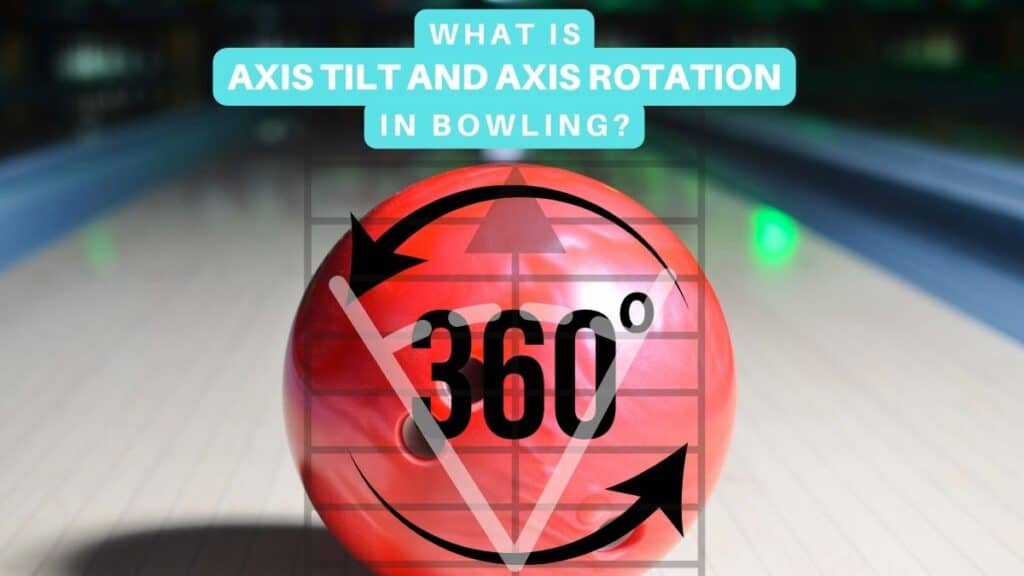There are a few bowling terms that may be confusing to beginner bowlers. Axis tilt and axis rotation are two of those terms. Unfortunately, many players fail to distinguish between these concepts and consider them the same.
Axis tilt refers to the angle of the bowling ball as it rolls down the lane. It can be either positive or negative. On the other hand, axis rotation is the turning of the bowling ball around its vertical axis, which can be forward or backward.
Both these concepts are essential in bowling, and they can have a significant impact on the outcome of a shot. Experimenting with different amounts of axis tilt and rotation is an excellent way to find what works best for you.
Here we will look at what these concepts mean when studied independently and how they are connected. This will help resolve the confusion and allow bowlers to improve their game.

What is Axis Tilt?
If we draw two lines on the ball dividing it from the middle on the x-axis and y-axis, the angle of the axis rotation above the horizontal line is the axis tilt.
For example, if you tilt the ball 10 degrees downward, the axis tilt will be positive 10 degrees. And if you tilt it 10 degrees upward, the axis tilt will be negative 10 degrees.
The position of your wrist determines the axis tilt. When you see the ball spinning on the bowling lane, it is a result of this position. The higher this angle, the more the spin and vice versa.
Axis tilt ranges from low to very high. An angle less than 11 degrees is considered low, whereas a tilt higher than 25 degrees is considered very high. A very high tilt is advantageous only when the ball speed is low. On the other hand, a low tilt may cause the ball to turn too early, which is not desirable.
Types of Axis Tilt
Axis tilt is of two main types: positive and negative.
Positive axis tilt is when the bowling ball is tilted towards the bowler. This can cause the ball to hook more, resulting in a more difficult shot. Negative axis tilt is when the bowling ball is tilted away from the bowler. This can cause the ball to slide more, making it easier to control.
One advantage of using a positive axis tilt is that it can help to increase the spin rate on the ball. This can be beneficial for bowlers who want to create more hooks on their shots. A higher spin rate can also help to increase the accuracy of the shot since the ball will be less likely to veer off course.
However, there are also some drawbacks to using a positive axis tilt. One is that it can make the ball more difficult to control. This can be a problem for bowlers who are already struggling with their accuracy.
Additionally, a positive axis tilt can make generating power on the shot more difficult. This can be a particular issue for shorter bowlers who need all the help they can get to generate enough momentum.
What is Axis Rotation?
Axis rotation is the amount of the ball’s side rotation when it is rolling down the lane. It varies from 0 to 90 degrees, with 45 degrees considered a medium or average axis rotation.
Axis rotation is an important aspect of bowling that can be used to control the ball’s trajectory. For example, if you don’t want the ball to hook more, you will have to make sure it rolls more end over end. Your hand’s position, in this case, will be 0 degrees in reference to the ball. It is termed minimum rotation.
On the other hand, increasing the side rotation helps to hook the ball more. For this to happen, you will need to hold the ball all the way to one side. This will cause the axis rotation to be close to 90 degrees (the maximum rotation).
A normal release is somewhere between the minimum and the maximum rotation.
Types of Axis Rotation
There are two types of axis rotation: forward and backward.
Forward axis rotation is when the thumb and middle finger are placed on opposite sides of the ball. The thumb is placed on the side of the ball that will be facing the bowler when the ball is released. This type of axis rotation will cause the ball to spin in a clockwise direction.
Backward axis rotation is when the thumb and middle finger are placed on the same side of the ball. The thumb is placed on the side of the ball that will be facing the bowler when the ball is released. The middle finger is placed on the opposite side of the ball. This type of axis rotation will cause the ball to spin in a counterclockwise direction.
Is it Better to Bowl Straight or Hook?
By now, you must be clear about the two concepts and how they relate. One important thing to remember is that a ball will not hook if axis tilt equals axis rotation. Or, axis rotation must always be higher than axis tilt for the ball to hook.
Now, the question is, is it better to bowl straight or hook?
While both approaches have pros and cons, it ultimately comes down to what you’re more comfortable with.
The hook aims to achieve a strike by giving the ball a better angle. When a ball is hit straight, the shot needs to be very precise in order to hit the pocket. Beginner bowlers may find it challenging to grasp the concept of axis tilt and rotation at first.
So, if you’re just starting out, you may want to bowl straight until you get a feel for the game. But hooking the ball can be a great way to add some spin and accuracy to your shots if you’re looking to up your bowling game.
Next article to read: How to Hook a Bowling Ball.





